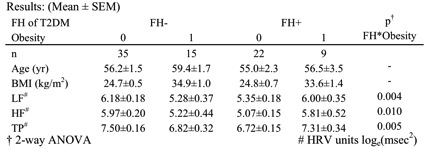Poster Presentation The Annual Scientific Meeting of the Australian Diabetes Society and the Australian Diabetes Educators Association 2013
Genetic susceptibility to type 2 diabetes influences the impact of obesity on heart rate variability (#316)
Aims: Type 2 diabetes mellitus (T2DM) commonly associates with obesity and is strongly heritable, with family history of T2DM (FH+) the strongest predictor of disease. The autonomic nervous system (ANS) links systems regulating energy balance, endocrine function and cardiovascular stability. In long-term poorly controlled diabetes, ANS function can be impaired, increasing risk of sudden death. More specific cardiac rate functions are impaired in FH+ and obesity estimated by heart rate variability (HRV) measures. However the interaction, if any, between FH and obesity on HRV measures is unclear. We aimed to assess the relationship between FH+ and obesity on measures of HRV in a dataset from our published studies of healthy non-diabetic subjects with known FH status.
Methods: Subjects (36 M, 47 F) were categorised FH+ (≥1 1st degree relative with T2DM) or FH- (no FH of T2DM); Obese (1, BMI≥30kg/m2) or Non-obese (0, BMI<30kg/m2). Resting, fasted electrocardiograph data (2 consecutive 8 min collections) were analysed for HRV in the frequency domain as total power (TP) and low frequency (LF, 0.04 – 0.15 Hz) and high frequency (HF, 0.15 – 0.40 Hz) bands.
 Subjects were well matched for age across all
categories and BMI within subgroups, without significant effects of age or
gender. All measures of HRV showed significant interactions between FH and
Obesity: obesity was associated with lower HRV in FH-, but with higher HRV in
FH+. Alternatively, FH+ was associated with lower HRV in non-obese, but with
higher HRV in obese subjects.
Subjects were well matched for age across all
categories and BMI within subgroups, without significant effects of age or
gender. All measures of HRV showed significant interactions between FH and
Obesity: obesity was associated with lower HRV in FH-, but with higher HRV in
FH+. Alternatively, FH+ was associated with lower HRV in non-obese, but with
higher HRV in obese subjects.
Conclusions: We conclude that the relationship between obesity and HRV depends on genetic susceptibility to T2DM. We postulate that reduced HRV in obese compared to non-obese FH- is largely due to reduced baroreflex sensitivity, while the effect of FH+ on HRV relates to the pathophysiology of T2DM itself.